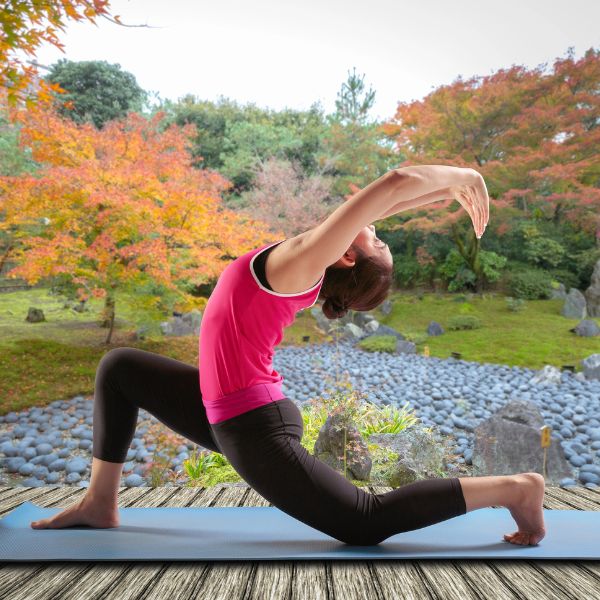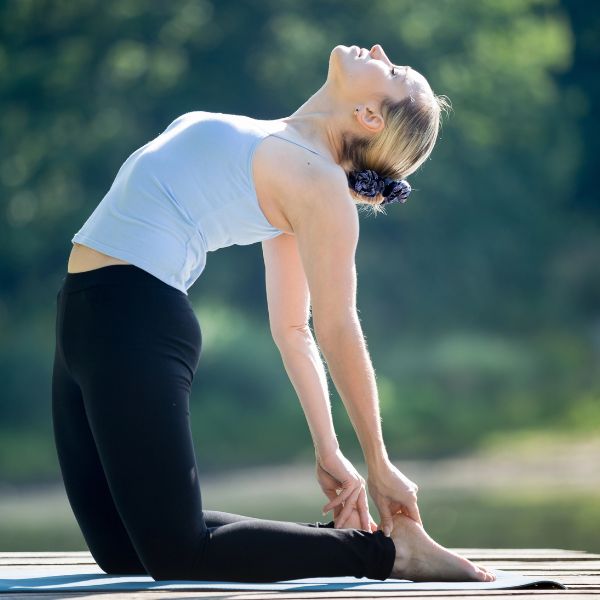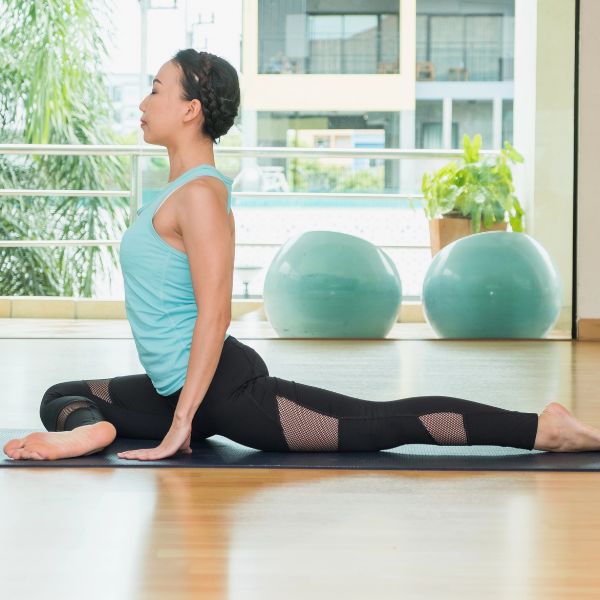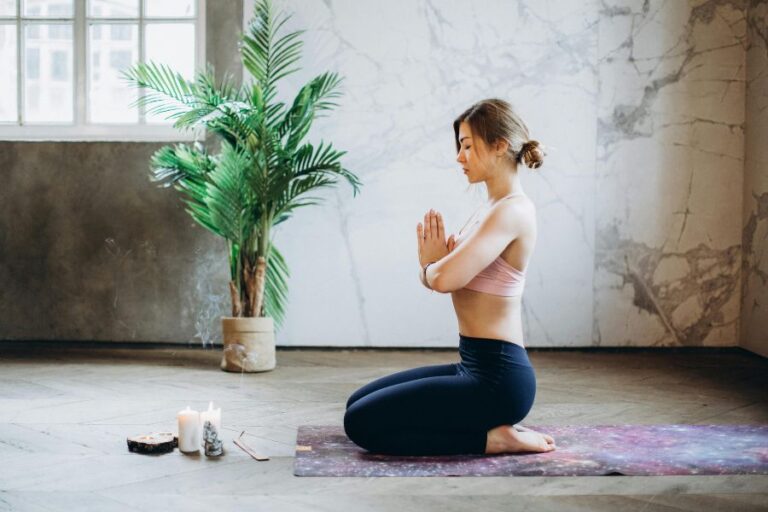We may earn money or products from the companies mentioned in this post.
Stress can take a significant toll on both our physical and mental health. Elevated cortisol levels, often caused by stress, have been proven to be detrimental to overall well-being. Therefore, it’s crucial to adopt effective methods for managing stress. While exercise and movement are widely recognized as excellent stress busters, yoga stands out as a particularly holistic and accessible option. Unlike many other forms of physical activity, yoga combines movement with mindfulness, offering a double dose of stress relief. It’s not just a method for weight loss. Yoga for stress management is a comprehensive approach to achieving mental and emotional balance.
In this post, we’ll explore the various ways you can utilize yoga for stress management. By delving into specific breathing techniques and other related practices, you’ll gain the tools needed to effectively reduce stress and enhance your quality of life. So, get ready to embark on a transformative journey toward a calmer and more centered you.

Stress and Your Body
Stress is not always a bad thing. To the body, stress is like an alarm system that lets you know something is wrong, but chronic or prolonged stress is not good. Ever feel fatigued, trouble sleeping, or have high blood pressure? Hese are symptoms of chronic stress. Lower your stress and start feeling better inside and out.
Benefits of Yoga for Stress Management
Practicing yoga offers numerous benefits that directly contribute to lowering stress. Here are some key ways in which reduced stress and yoga practice can benefit your overall health:
By incorporating yoga into your daily routine, you can effectively work towards lowering stress levels and reaping these extensive health benefits.

Yogic Breathing Techniques
There are two ways yoga can be used for stress reduction: Deep Breathing Techniques and Yoga Asana Sequences. Here is an introduction to a few yoga breathing techniques you need for stress management:
Introduction to Breathing Techniques
When it comes to yoga for stress management, one cannot underestimate the power of intentional breathing. The connection between the mind and body is profound, and by focusing on our breath, we can directly influence our mental state. Breathing techniques serve as a bridge, allowing us to access the calm and focus we often seek. Let’s dive into some effective breathing techniques that you can incorporate into your practice to manage stress better.
Diaphragmatic Breathing (Abdominal Breathing)

Explanation and Benefits: This technique harnesses the full capacity of your lungs, promoting relaxation and enhancing oxygen flow throughout the body. It’s perfect for reducing tension and encouraging a state of calm.
How to Practice:
- Find a comfortable seated or lying position.
- Place one hand on your chest and the other on your abdomen.
- Inhale deeply through your nose, allowing your abdomen to rise while your chest remains still.
- Exhale slowly through your mouth or nose, feeling your abdomen fall.
- Repeat for several minutes, focusing on deepening each breath.
Ujjayi Breath (Victorious Breath)

Explanation and Benefits: Known as the breath of victory, Ujjayi Breath improves concentration and provides a sense of inner strength. It also helps to warm the body, making it ideal during physical yoga practice.
How to Practice:
- Sit comfortably with your spine straight.
- Inhale through your nose, constricting the back of your throat slightly, as if fogging a mirror.
- Exhale with the same constriction, creating a gentle oceanic sound.
- Continue for several breaths, focusing on the rhythmic quality of your breath.
4-7-8 Breathing Technique

Explanation and Benefits: This technique promotes relaxation and helps to quickly reduce stress, making it a great option before bed or in any stressful situation.
How to Practice:
- Find a comfortable seated position.
- Inhale quietly through your nose for a count of 4.
- Hold your breath for a count of 7.
- Exhale completely through your mouth for a count of 8.
- Repeat for at least four breath cycles, focusing on the pattern to calm your mind.
By weaving these breathing techniques into your daily routine, you can make significant strides in managing stress and maintaining a balanced state. Whether you’re at work or unwinding at home, these practices serve as your go-to toolkit for effective stress relief.
Routines and Poses in Yoga for Stress Management
Yoga routines for stress management and relief are very beginner-friendly and easy to find on YouTube. While there are several Yoga YouTubers, my favorite is Yoga with Adriene. Her channel is full of different routines that show all of the holistic goodness hidden within a regular yoga practice. Here is a 7-minute stress relief routine great for any skill level:
Yoga for Stress Management (Poses)
The combination of mindful movement and breathwork in yoga fosters a powerful union of mind and body, ushering in a state of tranquility and balance. Here are three unique yoga poses that can be particularly effective in reducing stress and promoting relaxation.

Crescent Lunge (Anjaneyasana)
Crescent Lunge, or Anjaneyasana, is a powerful standing pose that energizes the entire body. Start in a standing position, step one foot back, and bend the front knee at a 90-degree angle. Keep your back leg straight and lift your arms overhead, reaching towards the sky. Hold the pose for several breaths, feeling a deep stretch in your hip flexors and quadriceps.
Benefits: This pose helps release tension stored in the hips and groin, areas where we often hold stress. Opening up these muscles promotes a sense of relaxation and balance, reducing overall anxiety.
Camel Pose (Ustrasana)
Camel Pose, or Ustrasana, opens up the chest and heart, creating a deep backbend. Kneel on the mat, hip-width apart, and place your hands on your lower back for support. Gently arch your back, lifting your chest towards the ceiling and letting your head drop back. Hold for a few breaths, focusing on the expansion in your chest and the stretch in your spine.
Benefits: This heart-opening pose can enhance your mood by increasing energy and improving respiration, helping to combat feelings of stress and fatigue. The deep stretch also releases tension stored in the back.


Half Pigeon Pose (Ardha Kapotasana)
Half Pigeon Pose, or Ardha Kapotasana, is a deep hip opener that targets the piriformis and glutes. Begin in a downward-facing dog, then bring your right knee forward, placing it behind your right wrist. Extend your left leg straight back. Keep your torso upright for a moment, then fold forward, resting your forehead on your hands or a prop.
Benefits: This pose deeply stretches the hip area, which is a common storage site for emotional stress and tension. Holding this position allows for a release of these pent-up emotions, promoting mental clarity and relaxation.
Yoga Nidra: Reduce Stress While Sleeping
Yoga Nidra, a super relaxing practice that’s often called yogic sleep. Imagine lying down comfortably, maybe with a blanket, and being guided into a state of deep relaxation. You’re not actually sleeping, but your body and mind are in a state that’s incredibly restorative—think of it as hitting the reset button.
Yoga Nidra works wonders for stress because it helps you tap into the space between wakefulness and sleep, where your brainwaves slow down. This state promotes deep physical and mental relaxation, melting away tension and anxiety. Plus, it’s accessible to everyone; you don’t need to be super flexible or experienced. Just find a quiet spot, lie back, and let the guided session lead you. Trust me, it’s like a mini-vacation for your mind and body, making it easier to handle whatever life throws at you. Give it a try and feel the stress just drift away!
Ready to Use Yoga for Stress Management?
Yoga for stress management is an incredible tool that offers both physical and mental benefits. From practicing calming poses to incorporating meditation, mindfulness, and even Yoga Nidra, there are countless ways yoga can help you find peace amidst life’s chaos. Restorative yoga poses provide deep relaxation, while journaling alongside your practice can enhance mental clarity and emotional well-being. By embracing these various aspects of yoga, you’ll equip yourself with powerful techniques to effectively manage stress. So why not roll out your mat and give it a try? Your mind and body will thank you for it!





